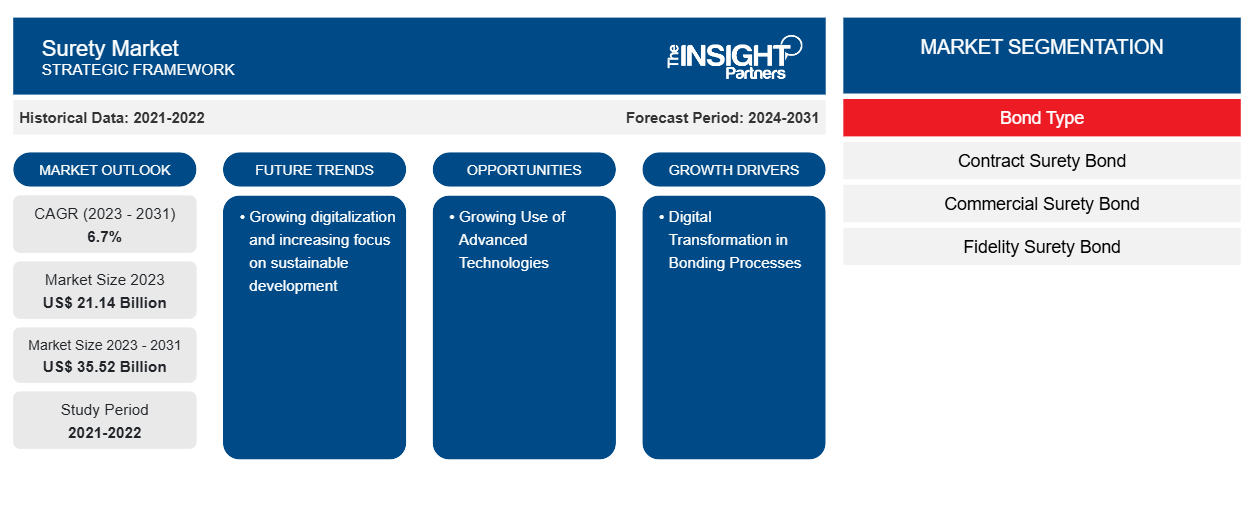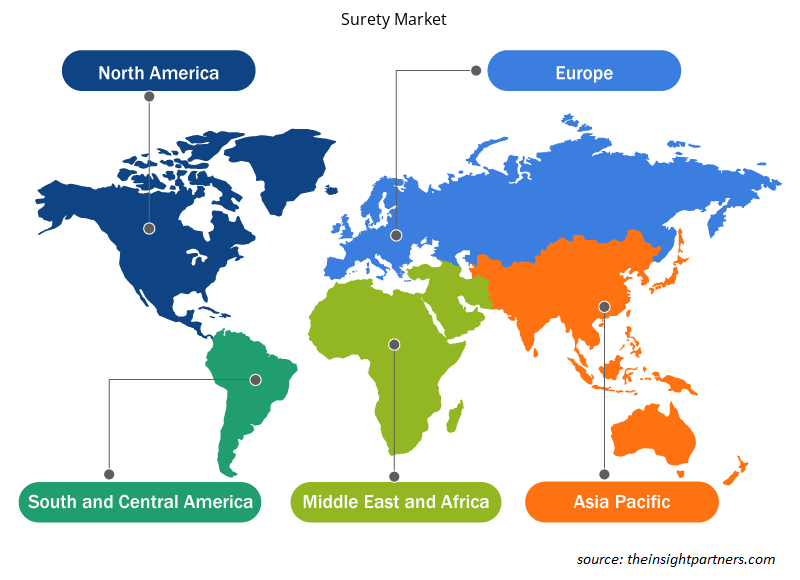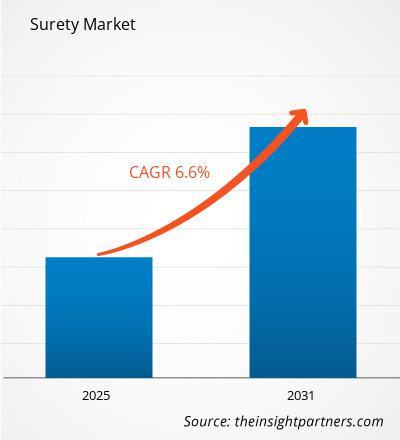Il mercato delle cauzioni è stato valutato a 20,26 miliardi di dollari nel 2024 e si prevede che raggiungerà i 31,85 miliardi di dollari entro il 2031, con un CAGR del 6,6% nel periodo 2025-2031. La crescente digitalizzazione e la crescente attenzione allo sviluppo sostenibile rimarranno probabilmente un trend chiave per il mercato delle cauzioni.CAGR of 6.6% during 2025-2031. Growing digitalization and increasing focus on sustainable development are likely to remain a key surety market trend.
Analisi del mercato delle fideiussioni
Il mercato delle fideiussioni sta crescendo rapidamente grazie al crescente numero di attività di costruzione e alla trasformazione digitale nei processi di fideiussione. Il mercato è in costante espansione, trainato dalla disponibilità di fideiussioni personalizzate e dalla crescente adozione di fideiussioni per la gestione dei rischi finanziari. Inoltre, il crescente utilizzo di tecnologie avanzate e la crescente attenzione ai fattori ambientali, sociali e di governance (ESG) stanno offrendo opportunità redditizie per la crescita del mercato.
Panoramica del mercato delle fideiussioni
La fideiussione è una garanzia finanziaria o un impegno a rispondere del debito, dell'inadempimento o del fallimento di un'altra persona. Si tratta di un accordo tripartito in cui una parte (il fideiussore) garantisce l'adempimento o gli obblighi di un'altra (il principale) nei confronti di una terza parte (il creditore). Una fideiussione funge da garanzia che una persona o un'organizzazione si assumerà la responsabilità di adempiere agli impegni finanziari in caso di inadempimento del debitore. La parte che garantisce il debito è nota come fideiussore o garante. Le fideiussioni possono essere ottenute emettendo fideiussioni, ovvero contratti legali che obbligano una parte a pagare qualora l'altra non rispetti l'accordo. Queste fideiussioni sono ampiamente utilizzate nei settori dell'edilizia, immobiliare, finanziario e dei trasporti per tutelare l'obbligazione contro l'inadempimento del principale.another's debt, default, or failure. It is a three-party agreement in which one party (the surety) guarantees the performance or obligations of another (the principal) to a third party (the obligee). A surety functions as an assurance that a person or organization will accept responsibility for meeting financial commitments if the debtor defaults and is unable to pay. The party that guarantees the debt is known as the surety or guarantor. Sureties can be obtained by issuing surety bonds, which are legal contracts that require one party to pay if the other fails to live up to the arrangement. These bonds are highly used by the construction, real estate, finance, and
Personalizza questo report in base alle tue esigenze
Riceverai la personalizzazione gratuita di qualsiasi report, incluse parti di questo report, analisi a livello nazionale, pacchetto dati Excel e potrai usufruire di fantastiche offerte e sconti per start-up e università.
Mercato delle cauzioni: approfondimenti strategici

- Scopri le principali tendenze di mercato di questo rapporto.Questo campione GRATUITO includerà analisi di dati che spaziano dalle tendenze di mercato alle stime e alle previsioni.
Fattori trainanti e opportunità del mercato delle cauzioni
La trasformazione digitale nei processi di bonding sta guidando il mercato
La trasformazione digitale è diventata uno dei fattori trainanti più evidenti degli ultimi anni. La rivoluzione digitale nelle operazioni di fideiussione sta sostituendo i tradizionali sistemi cartacei, aiutando gli utenti a ridurre i costi operativi aggiuntivi che stanno trainando il mercato. I tradizionali sistemi cartacei vengono sostituiti da piattaforme digitali che semplificano le richieste, le approvazioni e le emissioni delle fideiussioni. Le imprese edili di medie dimensioni possono valutare l'utilizzo di queste soluzioni digitali per ridurre la burocrazia, aumentare l'efficienza e abbreviare i tempi di elaborazione delle richieste di fideiussione.issuances. Middle-market construction companies can consider using these digital solutions to decrease paperwork, increase efficiency, and shorten bond application processing times.
Crescente utilizzo di tecnologie avanzate
La tecnologia diventerà sempre più cruciale nel settore delle fideiussioni. Le società di fideiussioni stanno investendo massicciamente in tecnologie avanzate come l'intelligenza artificiale, la blockchain e l'analisi dei big data per semplificare e migliorare le proprie operazioni. Ad esempio, la blockchain viene utilizzata per semplificare l'emissione delle fideiussioni e l'elaborazione dei sinistri, mentre l'analisi dei big data può aiutare a individuare possibili rischi e frodi. Pertanto, i significativi vantaggi offerti dalle tecnologie avanzate stanno creando opportunità redditizie nel mercato durante il periodo di previsione.
Analisi della segmentazione del rapporto sul mercato delle cauzioni
I segmenti chiave che hanno contribuito alla derivazione dell'analisi del mercato delle fideiussioni sono di tipo obbligazionario.
- In base alla tipologia di fideiussione, il mercato delle fideiussioni si suddivide in fideiussioni contrattuali, fideiussioni commerciali, fideiussioni di fedeltà e fideiussioni giudiziali. Il segmento delle fideiussioni contrattuali ha detenuto una quota di mercato maggiore nel 2023.
Analisi della quota di mercato delle fideiussioni per area geografica
L'ambito geografico del rapporto sul mercato delle cauzioni è suddiviso principalmente in cinque regioni: Nord America, Asia Pacifico, Europa, Medio Oriente e Africa e Sud America/Sud e Centro America.
In termini di fatturato, il Nord America ha rappresentato la quota maggiore del mercato delle fideiussioni, grazie alla crescente industrializzazione e al crescente numero di piccole imprese negli Stati Uniti e in Canada. Questi Paesi vantano un'economia solida e il sostegno favorevole del governo nella promozione e nella creazione di start-up sta stimolando il mercato. Le fideiussioni sono ampiamente utilizzate dalle piccole imprese per ottenere contratti e garantire ai propri clienti che un determinato lavoro verrà eseguito e completato nei tempi previsti. Le fideiussioni, emesse dalle società di fideiussione, sono richieste per una varietà di transazioni governative e commerciali . Si prevede che il crescente numero di piccole imprese nel settore edile nordamericano, insieme alla presenza di un numero significativo di operatori del mercato delle fideiussioni negli Stati Uniti e in Canada, guiderà il mercato delle fideiussioni.
Approfondimenti regionali sul mercato delle cauzioni
Le tendenze e i fattori regionali che influenzano il mercato delle cauzioni durante il periodo di previsione sono stati ampiamente illustrati dagli analisti di Insight Partners. Questa sezione illustra anche i segmenti e la geografia del mercato delle cauzioni in Nord America, Europa, Asia-Pacifico, Medio Oriente e Africa, e Sud e Centro America.

- Ottieni i dati specifici regionali per il mercato delle fideiussioni
Ambito del rapporto sul mercato delle cauzioni
| Attributo del report | Dettagli |
|---|---|
| Dimensioni del mercato nel 2024 | 20,26 miliardi di dollari USA |
| Dimensioni del mercato entro il 2031 | 31,85 miliardi di dollari USA |
| CAGR globale (2025-2031) | 6,6% |
| Dati storici | 2021-2023 |
| Periodo di previsione | 2025-2031 |
| Segmenti coperti | Per tipo di obbligazione
|
| Regioni e paesi coperti | America del Nord
|
| Leader di mercato e profili aziendali chiave |
|
Densità degli operatori del mercato delle cauzioni: comprendere il suo impatto sulle dinamiche aziendali
Il mercato delle cauzioni è in rapida crescita, trainato dalla crescente domanda degli utenti finali, dovuta a fattori quali l'evoluzione delle preferenze dei consumatori, i progressi tecnologici e una maggiore consapevolezza dei vantaggi del prodotto. Con l'aumento della domanda, le aziende stanno ampliando la propria offerta, innovando per soddisfare le esigenze dei consumatori e sfruttando le tendenze emergenti, alimentando ulteriormente la crescita del mercato.
La densità degli operatori di mercato si riferisce alla distribuzione delle imprese che operano in un determinato mercato o settore. Indica quanti concorrenti (operatori di mercato) sono presenti in un determinato spazio di mercato in relazione alle sue dimensioni o al suo valore totale.
Le principali società che operano nel mercato delle cauzioni sono:
- Crum & Forster
- CNA Financial Corp
- The Travelers Companies Inc
- Liberty Mutual Holding Co Inc
- Il gruppo assicurativo Hartford, Inc.
- Chubb Ltd
Disclaimer : le aziende elencate sopra non sono classificate secondo alcun ordine particolare.

- Ottieni una panoramica dei principali attori del mercato delle cauzioni
Notizie e sviluppi recenti sul mercato delle cauzioni
Il mercato delle fideiussioni viene valutato raccogliendo dati qualitativi e quantitativi a seguito di ricerche primarie e secondarie, che includono importanti pubblicazioni aziendali, dati di associazioni e database. Di seguito è riportato un elenco degli sviluppi nel mercato della fatturazione e della gestione dei ricavi delle telecomunicazioni e delle relative strategie:
- Core Specialty Insurance Holdings, Inc., compagnia assicurativa specializzata nel ramo danni, acquisirà American Surety con una transazione in azioni e contanti, dando vita a un sottosegmento di obbligazioni, crediti e garanzie, che si aggiungerà a Specialty Casualty, Property & Short-Tail e Fronted Programs. Il completamento di questa acquisizione è previsto per il primo trimestre del 2024. (Fonte: Core Specialty Insurance Holdings, Inc., comunicato stampa, 2023)
Copertura e risultati del rapporto sul mercato delle cauzioni
Il rapporto “Dimensioni e previsioni del mercato delle fideiussioni (2023-2031)” fornisce un’analisi dettagliata del mercato che copre le seguenti aree:
- Dimensioni e previsioni del mercato a livello globale, regionale e nazionale per tutti i segmenti di mercato chiave coperti dall'ambito
- Dinamiche di mercato come fattori trainanti, vincoli e opportunità chiave
- Principali tendenze future
- Analisi dettagliata delle cinque forze PEST/Porter e SWOT
- Analisi di mercato globale e regionale che copre le principali tendenze di mercato, i principali attori, le normative e i recenti sviluppi del mercato
- Analisi del panorama industriale e della concorrenza che copre la concentrazione del mercato, l'analisi della mappa di calore, i principali attori e gli sviluppi recenti
- Profili aziendali dettagliati
- Analisi storica (2 anni), anno base, previsione (7 anni) con CAGR
- Analisi PEST e SWOT
- Valore/volume delle dimensioni del mercato - Globale, Regionale, Nazionale
- Industria e panorama competitivo
- Set di dati Excel
Report recenti
Testimonianze
Motivo dell'acquisto
- Processo decisionale informato
- Comprensione delle dinamiche di mercato
- Analisi competitiva
- Analisi dei clienti
- Previsioni di mercato
- Mitigazione del rischio
- Pianificazione strategica
- Giustificazione degli investimenti
- Identificazione dei mercati emergenti
- Miglioramento delle strategie di marketing
- Aumento dell'efficienza operativa
- Allineamento alle tendenze normative




















 Ottieni un campione gratuito per - Mercato delle garanzie
Ottieni un campione gratuito per - Mercato delle garanzie